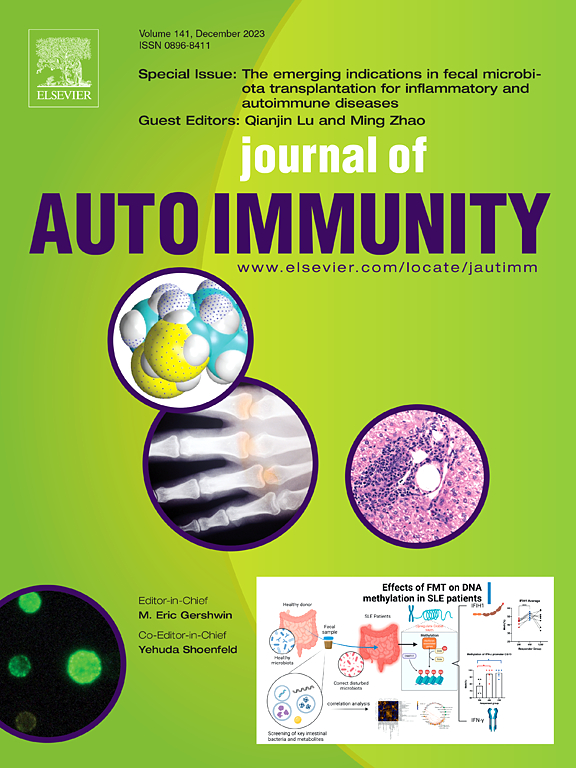Evaluation of minor labial salivary gland focus score in Sjögren's disease using deep learning: a tool for more efficient diagnosis and future tissue biomarker discovery
IF 7
1区 医学
Q1 IMMUNOLOGY
引用次数: 0
Abstract
Background
Sjögren's Disease (SjD) is histopathologically characterized by focal sialadenitis in minor labial salivary gland biopsies (mLSGB), which is evaluated by utilizing the focus score (FS). Focus score ≥1 identification is a critical step of the diagnostic approach and SjD classification. Nonetheless, during mLSGB analysis, FS reporting is neglected in a staggering 17 %, and a degree of inter-observer variability is introduced, even among specialized university centers. As the unmet need for reliable FS reporting is displayed, leveraging artificial intelligence in mLSGB evaluation shows encouraging potential and mandates to be investigated.
Methods
Minor LSGBs stained only with hematoxylin and eosin (H&E) during evaluation of individuals with a clinical suspicion of SjD, were randomly chosen from our archive. All mLSGBs were scanned digitally as whole slide images (WSI) and the final dataset was partitioned into a training (70 %) and a test set (30 %). An attention-based deep learning binary classification model was employed for evaluation of mLSGBs positivity (FS ≥ 1 or FS < 1).
Results
The final dataset consisted of 271 mLSGBs, with 153 (56 %) having FS < 1 and 118 (44 %) FS ≥ 1. In the FS ≥ 1 subset, 74 (63 %) were in the FS = 1–2 range, and the remaining biopsies had FS > 2, following the expected FS distribution among the typical SjD population. Our model resulted in: AUC = 0.932 (0.881–0.984), sensitivity 87 % (0.733–0.944), specificity 84 % (0.71–0.915) and accuracy 85.2 % (0.763–0.912), achieving better performance from previous works.
Conclusion
Artificial intelligence models may overcome the intra-observer biases and inter-observer variability in FS evaluation, reinforcing the diagnosis and biomarker discovery in SjD.

使用深度学习评估Sjögren疾病的小唇唾液腺焦点评分:一种更有效诊断和未来组织生物标志物发现的工具
背景舍格伦病(SjD)的组织病理学特征是小唇唾液腺活检(mLSGB)中的局灶性唾液腺炎,可通过病灶评分(FS)进行评估。病灶评分≥1的鉴定是诊断方法和SjD分类的关键步骤。然而,在 mLSGB 分析过程中,有高达 17% 的人忽视了 FS 报告,而且即使在专业的大学中心,观察者之间也存在一定程度的差异。方法在对临床怀疑患有 SjD 的患者进行评估时,从我们的档案中随机选取仅用苏木精和伊红(H&E)染色的轻微 LSGB。所有 mLSGB 都以整张幻灯片图像(WSI)的形式进行数字扫描,最终数据集被分为训练集(70%)和测试集(30%)。最终数据集由 271 个 mLSGB 组成,其中 153 个(56%)具有 FS <1,118 个(44%)具有 FS ≥1。在 FS ≥ 1 的子集中,74 例(63%)处于 FS = 1-2 的范围内,其余活检样本的 FS 为 2,符合典型 SjD 患者的预期 FS 分布。我们的模型得出结论人工智能模型可以克服FS评估中观察者内部的偏差和观察者之间的变异,从而加强SjD的诊断和生物标志物的发现。
本文章由计算机程序翻译,如有差异,请以英文原文为准。
求助全文
约1分钟内获得全文
求助全文
来源期刊

Journal of autoimmunity
医学-免疫学
CiteScore
27.90
自引率
1.60%
发文量
117
审稿时长
17 days
期刊介绍:
The Journal of Autoimmunity serves as the primary publication for research on various facets of autoimmunity. These include topics such as the mechanism of self-recognition, regulation of autoimmune responses, experimental autoimmune diseases, diagnostic tests for autoantibodies, as well as the epidemiology, pathophysiology, and treatment of autoimmune diseases. While the journal covers a wide range of subjects, it emphasizes papers exploring the genetic, molecular biology, and cellular aspects of the field.
The Journal of Translational Autoimmunity, on the other hand, is a subsidiary journal of the Journal of Autoimmunity. It focuses specifically on translating scientific discoveries in autoimmunity into clinical applications and practical solutions. By highlighting research that bridges the gap between basic science and clinical practice, the Journal of Translational Autoimmunity aims to advance the understanding and treatment of autoimmune diseases.
 求助内容:
求助内容: 应助结果提醒方式:
应助结果提醒方式:


